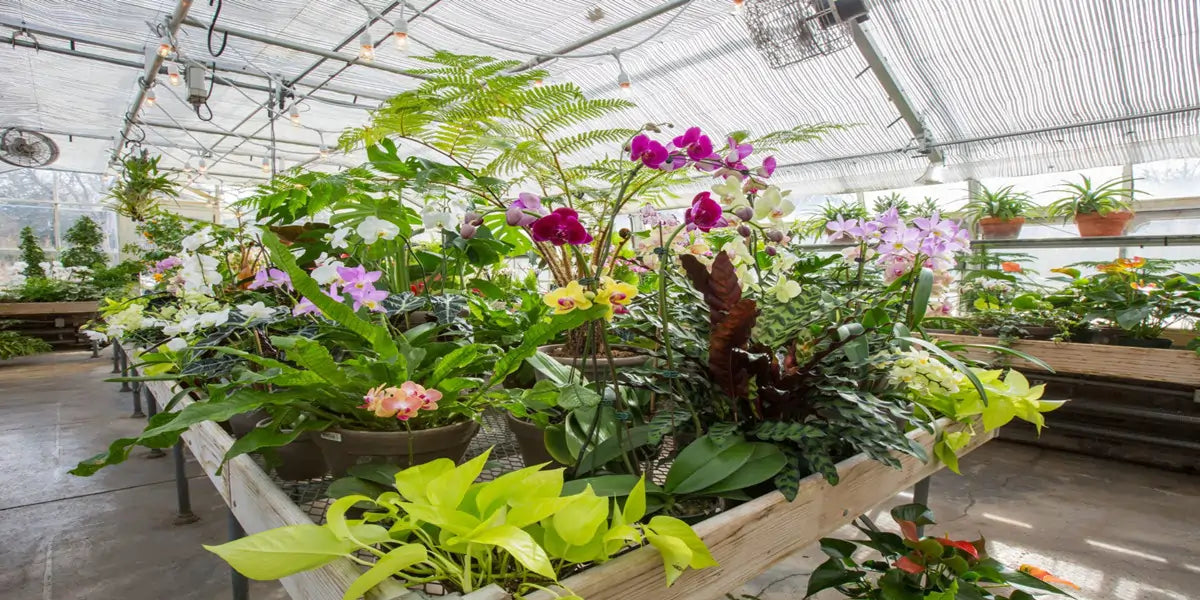No matter how perfect the protection you provide for your greenhouse plants seems, plants can be affected by pests and diseases. Once you neglect your plants, these unwanted guests can harm them.
In a backyard greenhouse, a small number of pests won't cause major problems. But a large number of pests can cause major damage to your greenhouse plantings.
First, You need to know: the source of pests and diseases and the signs. These information helps you tell if your greenhouse plants are infected.
Sources of greenhouse plant diseases and pests
Water
Gardeners often need to water their plants, especially during the summer months. But water often carries a variety of bacteria in it. Blastomyces and Pythium, which can cause stem rot, and cut-strip rot are the main pathogens that can enter the greenhouse through the water and infect the plants.
Soil
Many plant pathogens are carried into the greenhouse in the soil. Fungi, oomycetes, bacteria, and nematodes may all be present in the soil.
 (soil in garden)
(soil in garden)
When you plant plants into a soil mixture containing these pathogens, the pathogens are stimulated by nutrients from the plant roots. The pathogens will then begin to attack your plants.
Plants that grow year-round
Some pathogens can only survive on living plant tissue. Rust diseases, such as geranium or fuchsia rust, must spread among living plants or they will die quickly. Powdery mildew fungi may be parasitic on grapevines, begonias, roses, and African violets. When you notice signs of disease on the stems and leaves of other plants such as flowers, you should pay attention. If you ignore these phenomena, the situation will get worse. If the light, temperature, and humidity are conducive to the growth of pathogens, the disease can spread rapidly.
Plant debris
Most plant pathogens can be parasitic not only on living plant tissue but also on plant debris. In winter, when pathogens are dormant, they can survive for a period at extreme temperatures.

(fallen leaves)
They may be dormant in the roots or dead leaves of plants that have caused disease. In these plant tissues, they are safe. These plant pathogens are protected from harsh environments and kept away from competition with other organisms.
Air
Pathogens can enter the greenhouse with airflow. Pathogen-infected plants or weeds in outdoor gardens can provide large numbers of spores.
In winter, pathogen activity is suppressed. Even if the greenhouse is infected, the signs are not too obvious. In the spring and summer, pathogens are more active and greenhouse plants are likely to be attacked by airborne pathogens. Therefore, gardeners should create conditions in their greenhouses that suppress pathogen activity. At the same time, gardeners should also eliminate sources of pathogens from outside the greenhouse. Herbicides or pesticides should be used with caution in the vicinity of the greenhouse.
Identifying pests and diseases in the greenhouse
The following are a few common greenhouse pests and diseases.
Pests
Aphids. Aphids are a common pest in greenhouses. Aphids are small and not easily detected, but reproduce rapidly. During reproduction, aphids can quickly spread viruses. If you notice that your plants are starting to grow twisted or that the leaves are bending inward, this indicates a possible aphid infection. If the plant is infected with aphids, you will also find a sticky substance on the stems and leaves, which then turn black or even moldy.
Aphids often lurk on the underside of leaves. Aphids come in many colors, including black, gray, green, and yellow.
Whiteflies. Whiteflies can cause a great deal of stress to your greenhouse gardening. If you are growing succulents in your greenhouse, it is especially important to prevent whiteflies. Whiteflies like to nibble on succulents which can affect the plant's ability to photosynthesize. If you notice that your plants are growing slowly, you should check to see if your plants are infected with whiteflies.

(whiteflies on leave)
The whitefly will pierce the leaves and suck out the sap. If you are examining the leaves and find that the plant is discolored, dry, and sticky to the touch, your plant is probably infected.
Thrips. Thrips like to eat the sap from leaves and flowers. This pest prevents flower buds from blooming and causes plants to grow distorted. If you notice your plants becoming dull or discolored, you should suspect that your greenhouse is being attacked by thrips.

(thrips damage)
If the plant leaves are infected with thrips, they are likely to have black or brown spots.
Snails. Snails are a common greenhouse pest. Snails can absorb nutrients from the soil and affect plant growth. Also, snails can eat entire crops. When you notice sticky residue or bite marks on the stems and leaves of your plants, it's time to wonder if you have snails in your greenhouse.
Mites. Mites are tiny, red, eight-legged creatures. This pest is commonly found in greenhouses and will slowly nibble on plants.
When mites begin to harm your plants, it is initially difficult for you to spot them. Then small black or brown spots will appear on the leaves of the plant. The mites may make webs next to the plant. If you notice these phenomena, you should take action.
Diseases
Powdery mildew. Powdery mildew is a common fungal disease that can quickly kill vegetables, fruits, and other plants in the greenhouse. Powdery mildew is easy to recognize, and you can find a white powdery substance on the leaves of infected plants.

(Powdery mildew)
This white powder may also be found on stems, flower buds, and fruit. Powdery mildew can cause leaves or flowers to rot or fall off. This fungus often affects plants in the shade.
Black spot disease. Black spot is one of the most common plant diseases. This fungal disease causes black circular spots to grow on the leaves of the plant. If you notice spots on plant leaves, you should remove the infected leaves immediately to prevent the disease from spreading to other leaves.

(Black spot disease)
Severe infections can cause leaves to turn yellow and fall off. Black spot disease is common in areas that are wet all year round.
Sooty mold. Sooty mold is a fungal disease caused by the growth of several different species of fungi. These fungi feed on honeydew secretions (a sticky substance produced by certain insects).
 (sooty mold disease)
(sooty mold disease)
As the fungus grows, dark-colored mycelium that looks like soot appears on the plant's foliage. The manifestation can be large, dark clumps or small spots.
Soot mold is a growth on the surface of plant tissues that, while not causing direct infection to plants, can still harm plants. As the fungus grows, they cover the entire leaf so that the leaf cannot receive sunlight. The ability of plants to carry out photosynthesis is reduced.
Downy mildew. Downy mildew is a common disease in greenhouse growth. Many plants can be infected with downy mildew. The growth and development of downy mildew cannot occur without high humidity. If the environment is too dry, spores will stop forming and developing.

(downy mildew)
In a greenhouse, the gardener can think of controlling the temperature as well as the humidity conditions. Downy mildew is controlled to some extent. In humid and rainy areas, if the gardener transplants outdoor plants into the greenhouse, the probability of the plants being infected with downy mildew is high.
Black root rot. Black root rot is caused by the fungus Thielaviopsis. Many greenhouse gardeners misdiagnose black root rot as a nitrogen or other nutrient deficiency. Look carefully at your greenhouse plants to see if only certain plant groups are growing irregularly and not all of them.

(root rot on plants)
If certain plants look abnormal, then they are likely infected with black root rot. Flowers such as pansies, geraniums, poinsettias, and goldenrod are susceptible to black root rot.
What should you do?
To prevent pests and diseases from harming plants, greenhouse gardeners should observe plants regularly and manage the greenhouse well. Prevention is more important than treatment and is also more cost-effective.
If you are unfortunate to find that a plant is infected, you should take prompt action. We will discuss pest and disease management in greenhouses in the next blog.








